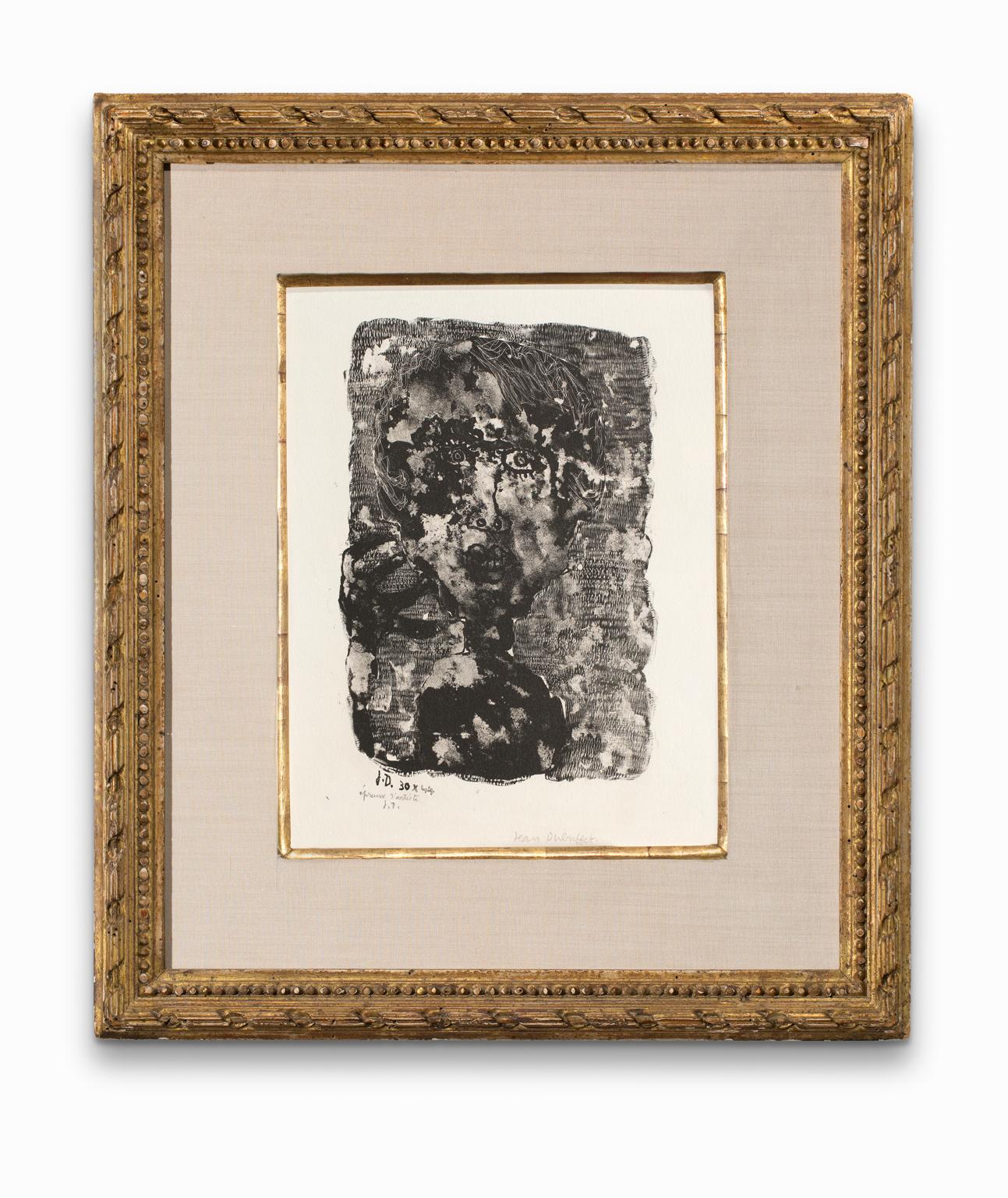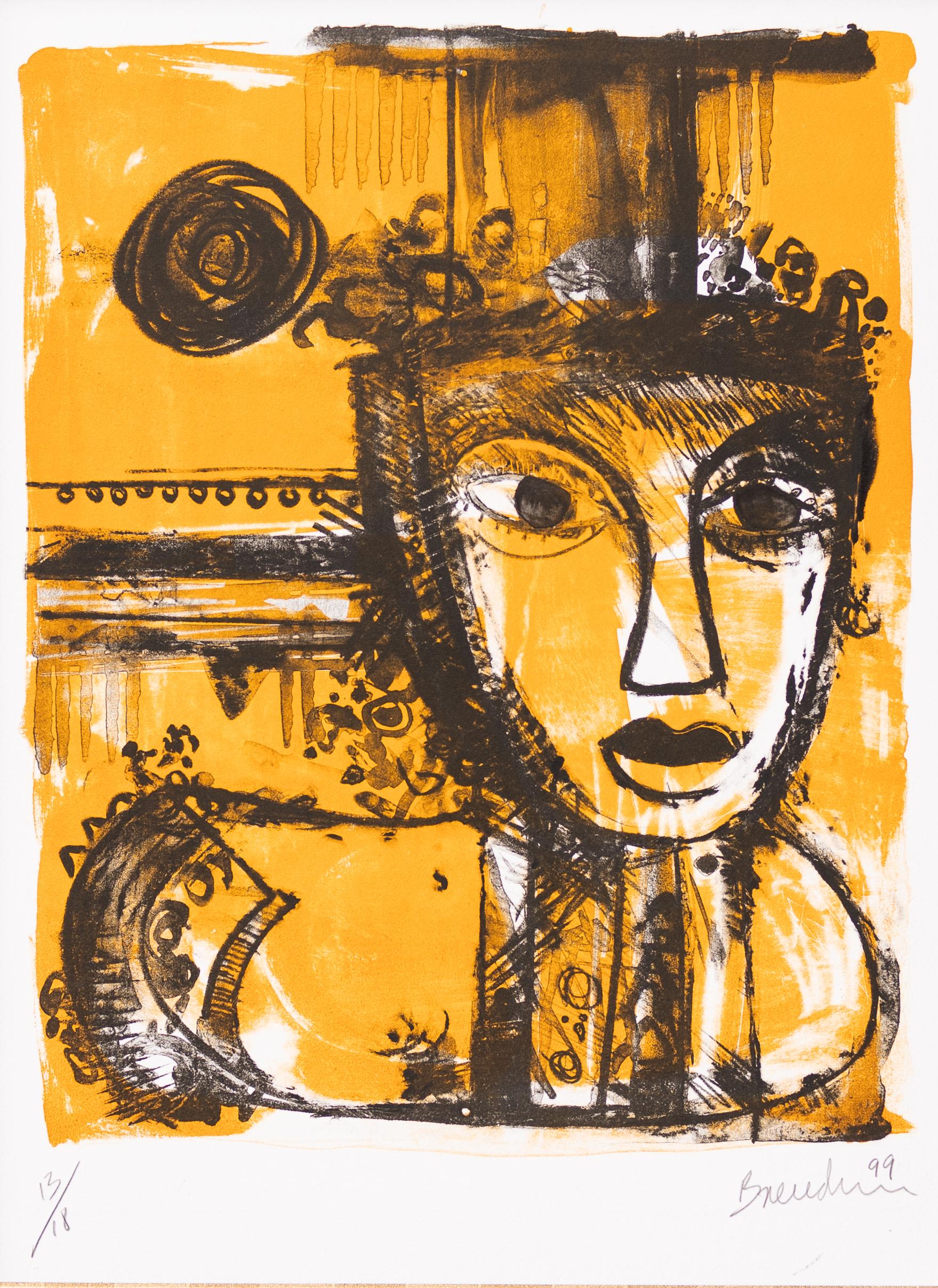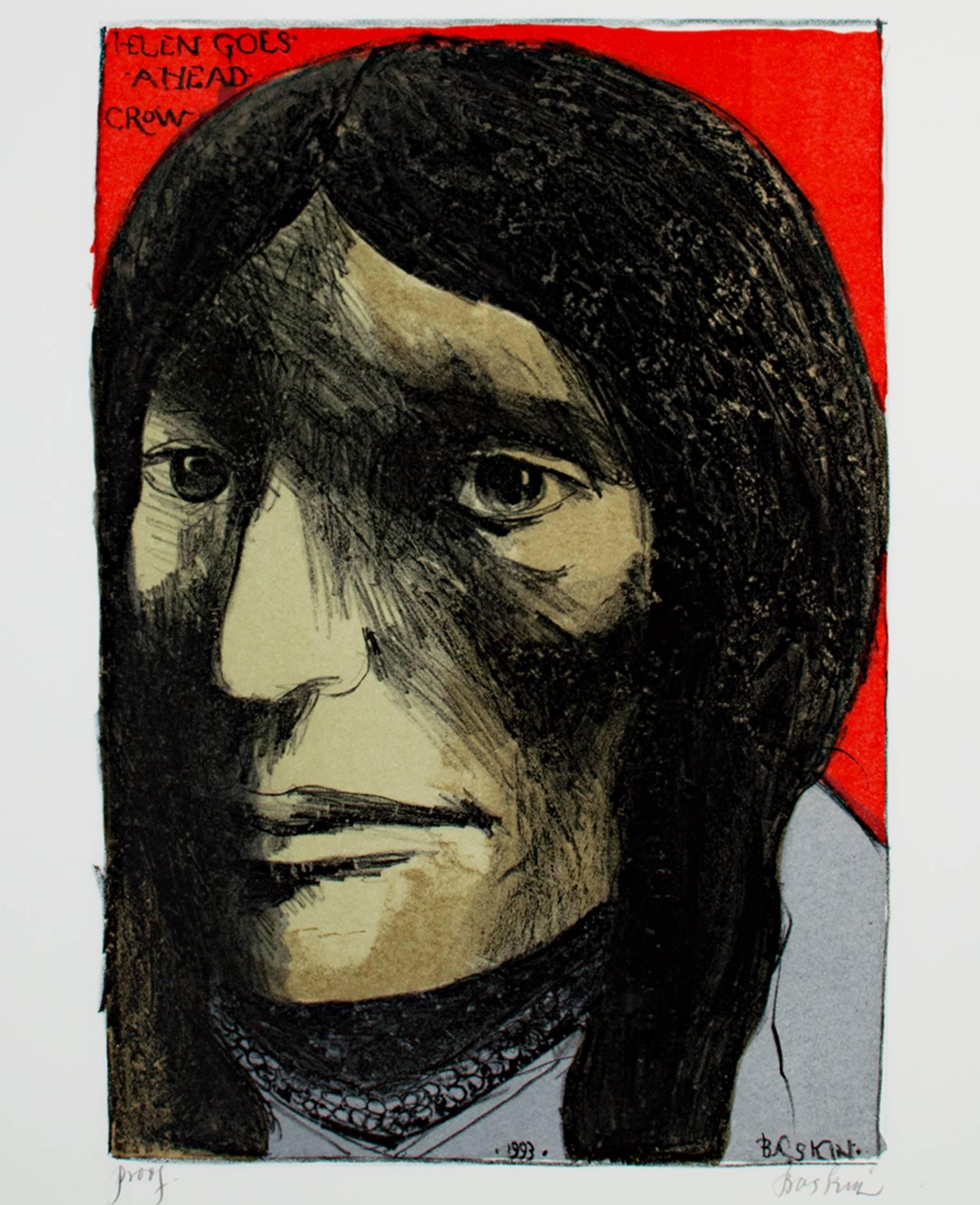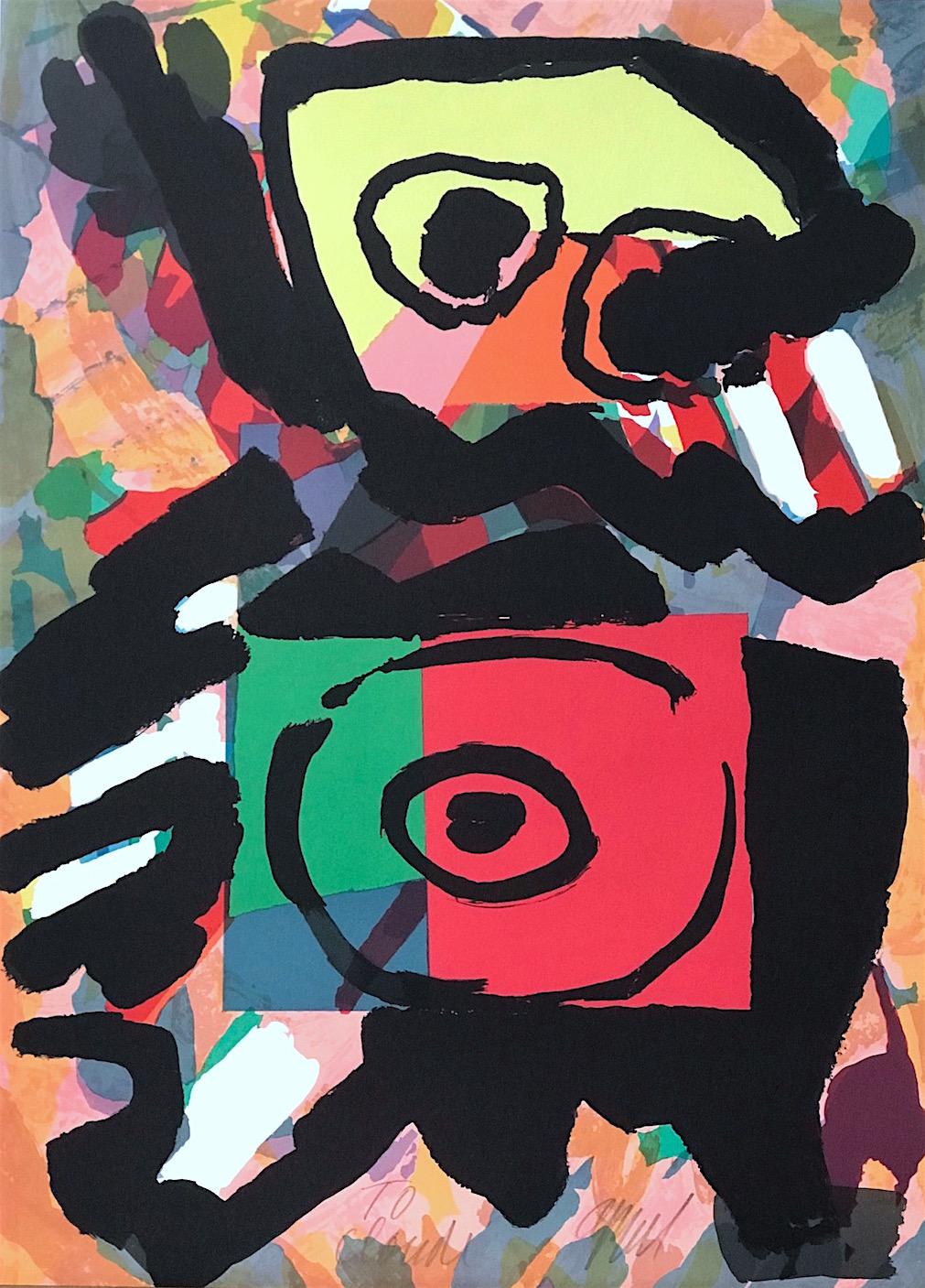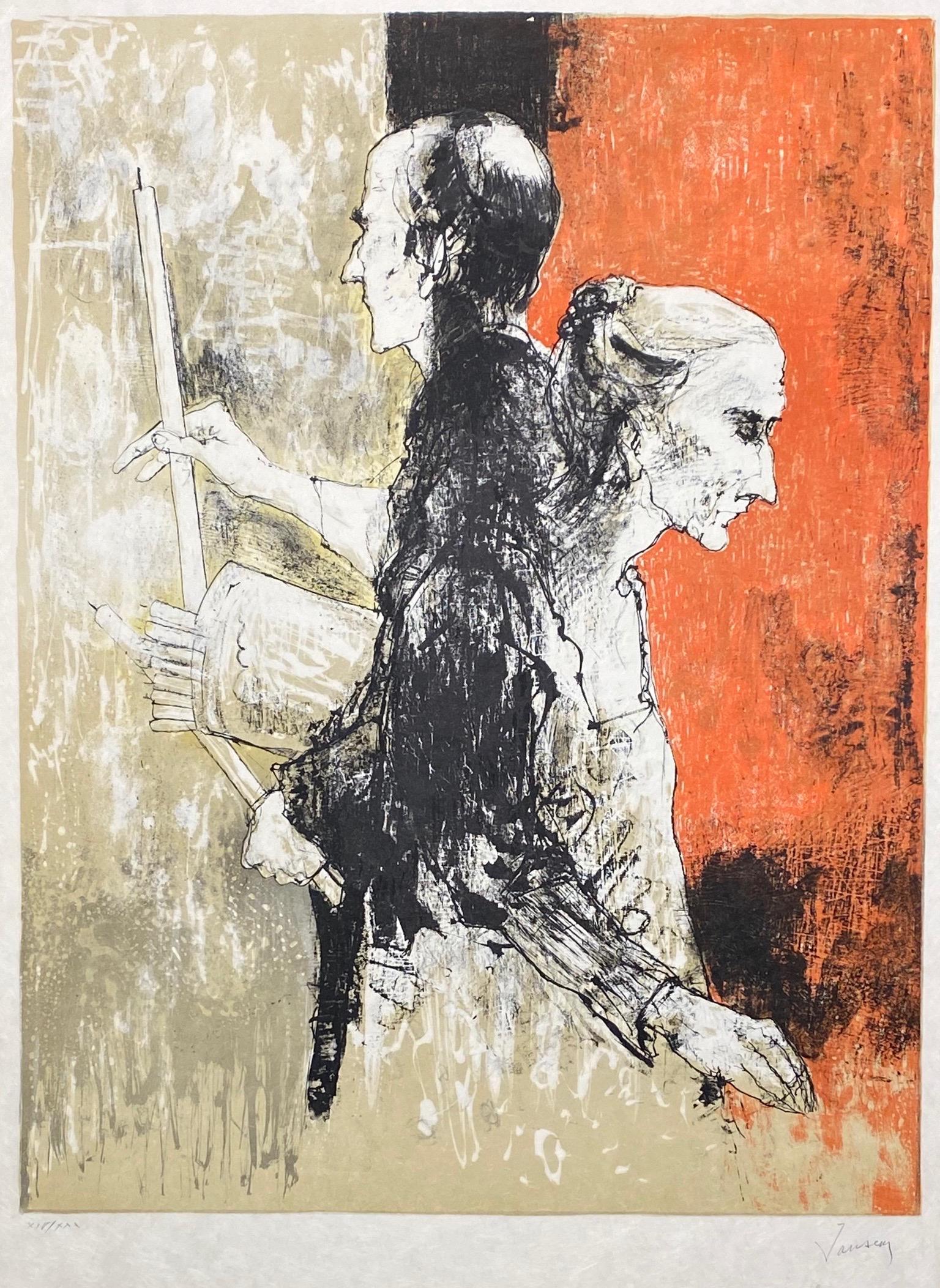Items Similar to Richard Linder "Red Head" Lithograph Figurative Portrait
Want more images or videos?
Request additional images or videos from the seller
1 of 13
Richard LinderRichard Linder "Red Head" Lithograph Figurative Portrait1971
1971
About the Item
“Red Head” is a portrait that puts dynamic and powerful to shame. This woman from the 1970s at the height of the Feminist movement is an Amazon. Though you cannot see her body her powerful and determined gaze is that of an individual who knows where she is going and what she wants. Best if you get out of her way. Nonetheless, the aura she creates is hypnotizing and the viewer must struggle to break the spell or be absorbed into her presence. This spell-binding piece of Linder’s is unique in its ability to exude a physical push and pull upon its audience.
Richard Linder is a German-American artist who used bold colors and abstracted graphic designs in his figures losing softness or nuance for hard edged primary shapes. There is a similarity in approach and intent with two other German artists working around the same time, Max Beckmann and Marsden Hartley. Max Beckmann also loses nuance in his portraits that in turn gain psychological power by their overwhelming force of presence. In his 1914 -- 1915 German paintings, Marsden Hartley tended to bold colors and graphic abstraction. All three artist’s works have the visual and emotional impact that can only be described as a physical punch to the eye and psyche.
Claus Clement has said of Lindner that “The artistic universe of Richard Lindner is unique: he is highly genuine, he is full of urban energy, and he is driven by weird eroticism… He started his career as an artist eventually at the age of 40 in New York. In this metropolitan jungle Lindner created his oeuvre: exciting and powerful images of robot like figures, amazons and heroines, harlequins of self-styled heroes – his artistic panorama of the unruly 60s and 70s of the 20th century.”
From 1924 to 1927 Lindner lived in Munich and studied at the Kunstakademie. In 1927 he moved to Berlin returning to Munich in 1928 to become art director of a publishing firm. He remained in Munich until 1933, when he was forced to flee to Paris. Once in Paris, he became politically engaged, sought contact with French artists and earned his living as a commercial artist. He was interned when World War II broke out in 1939 and later served in the French Army.
In 1941, Lindner moved to the United States and worked in New York City as an illustrator of books and magazines. There he made contact with New York artists and German emigrants such as Albert Einstein, Marlene Dietrich, and Saul Steinberg. In 1948, he became an American citizen.
Lindner started teaching at the Pratt Institute, Brooklyn in 1952 and received the William and Norma Copley Foundation Award in 1957. He became Guest Professor at the Hochschule fur bildende Kunste in Hamburg returning to Germany in 1965 to accept the post.
His paintings at this time used the sexual symbolism of advertising and investigated definitions of gender roles in the media. In 1967 he moved to Yale University School of Art and Architecture, New Haven, Connecticut.
His work is in both private and corporate collections and numerous art museums.
Signed and Dated by artist
Lithograph # 42/120
fills the frame
- Creator:Richard Linder (American)
- Creation Year:1971
- Dimensions:Height: 30.5 in (77.47 cm)Width: 23.25 in (59.06 cm)
- Medium:
- Movement & Style:
- Period:
- Condition:
- Gallery Location:Detroit, MI
- Reference Number:1stDibs: LU128619241062
About the Seller
5.0
Vetted Seller
These experienced sellers undergo a comprehensive evaluation by our team of in-house experts.
Established in 2014
1stDibs seller since 2019
96 sales on 1stDibs
Typical response time: 4 hours
- ShippingRetrieving quote...Ships From: Detroit, MI
- Return PolicyA return for this item may be initiated within 14 days of delivery.
More From This SellerView All
- Jean Dubuffet Artist Proof Signed Lithograph "Sophisticated Lady"By Jean DubuffetLocated in Detroit, MISALE ONE WEEK ONLY "Sophisticated Lady", a lithograph, is an exemplary work indicative of DuBuffet's early work and style. It is a playful and iron...Category
1940s Expressionist Portrait Prints
MaterialsLithograph
- Kiki Smith "Noon 2007" Engraving Portrait Musician Ryan BinghamBy Kiki SmithLocated in Detroit, MI" Noon 2007" Portrait of Musician Ryan Bingham engraving by Kiki Smith of a young man looking directly at the viewer. His look is not one of challenge, but more of a questioning nature. It is numbered on verso 28/33, and dated 2007. Kiki Smith (1954 - ) is a West German-born American artist. Her work encompasses many themes: sex, birth, regeneration and death along with personal investigation of her life and those of her family. Her figurative work of the late 1980s and early 1990s confronted subjects such as AIDS and gender. Her recent works have depicted the human condition in relationship to nature. Smith lives and works in New York City and the Hudson Valley, New York State. Her father was sculpture artist, Tony Smith and her mother was actress and opera singer Jane Lawrence. Although Kiki's work takes a very different form than that of her parents, early exposure to her father's process of making geometric sculptures allowed her to experience formal craftsmanship firsthand. Smith was enrolled at Hartford Art School in Connecticut for eighteen months from 1974 to 1975, then moved to New York City in 1976 and joined Collaborative Projects (Colab), an artist collective. The influence of this radical group's use of unconventional materials can be in seen in her work. For a short time in 1984, she studied to be an emergency medical technician and sculpted body parts, and by 1990, she began to craft human figures. In addition to print making Kiki Smith has created in a number of different mediums such as film, sculpture, tapestries, books and the confines of commissions. She experimented in a wide range of printmaking processes. Some of her earliest print works were screen-printed dresses, scarves and shirts, often with images of body parts. In association with Colab, Smith printed an array of posters in the early 1980s containing political statements or announcing Colab events. In 1988 she created "All Souls”, a fifteen-foot screen-print work featuring repetitive images of a fetus, an image Smith found in a Japanese anatomy book...Category
Early 2000s American Modern Portrait Prints
MaterialsEngraving
- "Formal Dress Called <Of The Maghzen>", from "Costumes of Morocco"Located in Detroit, MI"Costume du D'Apparat dit du Maghzen" translated to "Formal Dress Called " is plate number 14 in Jean Besancenot's stunning portraits and depictions of...Category
1940s Portrait Prints
MaterialsPaper, Gouache
- "Woman of Tiznit Wearing the Amendil", from "Costumes of Morocco"Located in Detroit, MI"Femme de Tiznit Portant L'Amendil" translated to "Woman of Tiznit Wearing the Amendil" is plate number 47 in Jean Besancenot's stunning portraits and ...Category
1940s Portrait Prints
MaterialsGouache, Paper
- "Jewish Woman of the Tafilelt" from "Costumes of Morocco", Gouache on PaperLocated in Detroit, MI"Juive du Tafilelt" translated to "Jewish Woman of the Tafilelt" is plate number 55 in Jean Besancenot's stunning portraits and depictions of the peopl...Category
1940s Portrait Prints
MaterialsPaper, Gouache
- "Jewish Bride of Fez" from "Costumes of Morocco", Gouache on PaperLocated in Detroit, MI"Mariée Juive de Fès" translated to "Jewish Bride of Fez" is plate number 52 in Jean Besancenot's stunning portraits and depictions of the people of Morocco from his series "Costumes du Maroc" ("Costumes of Morocco). The woman depicted here is a young Jewish woman dressed for her wedding. She is dressed in traditional fashion for a Jewish wedding for the community in Morocco, a community with a long history in the region, especially the city of Fez, the second largest city in Morocco and known as the "Mecca of the West" for its contributions to religion and learning. For this reason and its northern proximity, Fez was a prominent destination for Jews fleeing Spain. Jewish history in Morocco is long, dating back to the 1st century, their numbers later increased by the Sephardic Jews who were expelled from Spain in 1492 by the Alhambra Decree. Jean Besancenot's sixty plate reproduced and handcolored gouache on paper study on the diversity of Morocco's cultures is a work of stunning historical importance in tracing the rich and vibrant diversity of North Africa. Besancenot spent the 1930s traveling around Morocco, undertaking an awe-inspiring study of its peoples and rendered in vivid and precise detail the way they traditionally lived and dressed. Many of those outfits and cultural expressions are gone now, with Besancenot's watercolored drawings of them some of the only ways that people can now visit the past. The original manuscript of "Costumes du Maroc" is kept in the Royal Collection in Rabat, with only 310 copies of it produced. These prints are fresh from the folio and have been newly museum framed under conservator glass; unframed the image of the print is 12.75 x 7.75 inches. The tissue guards that bear the caption of the plate have been framed in the verso with the title visible behind clear plastic. Jean Besancenot, real name Jean Girard, was a photographer, painter, designer, and ethnologist who was born in 1902 in Estrées-Saint-Denis. His work straddles the crossroads of art and ethnography as he was primarily interested in the costumes and ornaments of Morocco in the first half of the 20th century. He arrived for the first time in Morocco in 1934, a country he traveled through until 1939. There he produced a very rich ethnographic documentation on the traditional costumes and adornments of the different Moroccan ethnic groups. His work, composed of photographs, films, drawings and paintings, testifies to the aestheticism of Moroccan cultural heritage that was still marked by little Western influence. His book "Costumes du Maroc" was published in 1942 at the end of his first trip and presents 60 documented plates of Moroccan costumes...Category
1940s Portrait Prints
MaterialsGouache, Paper
You May Also Like
- UntitledBy Paul KleinschmidtLocated in Austin, TXArtist: Paul Kleinschmidt (German, 1883-1949) Title: Untitled Date: 1923 Medium: Lithograph on paper Signed in pencil Dimensions: 16.5"h x 13.5"w (sight), 25.5"h x 19"w (with frame) Provenance: The Estate of Roberta Kimmel Cohn, NY; Property from a Private Estate, NY; ACA Galleries...Category
1920s Expressionist Portrait Prints
MaterialsLithograph
- Orange Face, Expressionist PortraitLocated in Austin, TXBy Juan Carlos Breceda 21" x 15" Lithograph - 13/18 Framed Size: 35.5" x 30.5"Category
Late 20th Century Expressionist Abstract Prints
MaterialsLithograph
- Original Lithograph Native American Female Figure Portrait Bold Stoic SignedBy Leonard BaskinLocated in Milwaukee, WI"Helen Goes Ahead- Crow" is an original lithograph proof signed by the artist Leonard Baskin. It depicts a Crow woman named Helen Goes Ahead in front of a red background. 19" x 12 ...Category
1990s Expressionist Portrait Prints
MaterialsLithograph, Ink
- MULTI PERSONAGE Signed Lithograph, Abstract Collage Portrait, CoBrA ArtistBy Karel AppelLocated in Union City, NJMULTI PERSONAGE is an original limited edition lithograph by the Dutch artist Karel Appel, printed using hand lithography techniques on archival Arches paper, 100% acid free. MULTI PERSONAGE is a lively abstract color collage portrait expressed in vibrant shades of red, blue, pink, green, purple, yellow with hints of multi color pastel tones and white creating an abstracted body and face. Bold black paint strokes define the face with its zany black eyes, head, body and limbs; collage effect torn paper bits fill in the body form. MULTI PERSONAGE is a very unique, fantastically playful and wild composition by Karel Appel, one of the founders of the avant-garde art movement CoBrA active during the late 1940's thru early 1950's. His paintings are known for incorporating applications of vibrant, violent colors often possessing a primal, childlike quality. Print size - 30 x 20 inches, unframed, excellent condition, pencil signed by Karel Appel Edition size - 175 Year published - 1980 Printer - JK Fine Art Editions Co., NY Karel Appel was one of the founders of the avant-garde art movement CoBrA, active during the late 1940's thru early 1950's. His paintings are known for incorporating applications of vibrant, violent colors often possessing a primal, childlike quality. Karel Appel, (born April 25, 1921, Amsterdam, Netherlands—died May 3, 2006, Zürich, Switzerland), Dutch painter of turbulent, colorful, and semi-abstract compositions, who was a co-founder (1948) of the CoBRA group of northern European Expressionists. He was also a noted sculptor and graphic artist. Appel attended the Royal Academy of Fine Arts, Amsterdam (1940–43), and helped found the “Reflex” group, which became known as CoBRA (for Copenhagen, Brussels, and Amsterdam), in 1948. He moved to Paris in 1950 and by the 1960s had settled in New York City; he later lived in Italy and Switzerland. Partly in reaction against what they perceived as the sterile academicism of the de Stijl movement, the CoBRA artists...Category
1980s Expressionist Portrait Prints
MaterialsLithograph
- Pèlerin au cierge, 1986, original lithograph by Jean Jansem, signed and numberedBy Jean JansemLocated in Carouge GE, GEJean Jansem (1920-2013) Pélerin au cierge, 1986 Lithographie sur papier Japon, justifiée XIV / XXX Signée en bas à droite 67 x 51 cm / 76 x 54 cm Bibliographie: CR Jansem, 1993, n...Category
Late 20th Century Expressionist Figurative Prints
MaterialsLithograph
- Nordjyllands Kunstmuseum (The Brooch. Eva Mudocci) Poster /// Edvard Munch LithoBy Edvard MunchLocated in Saint Augustine, FLArtist: (after) Edvard Munch (Norwegian, 1863-1944) Title: "Nordjyllands Kunstmuseum (The Brooch. Eva Mudocci)" Year: 1973 Medium: Original Lithograph, Exhibition Poster on heavy wove paper Limited edition: Unknown Printer: Unknown Publisher: Nordjyllands Kunstmuseum, Aalborg, Denmark Sheet size: 35" x 21.5" Image size: 24.75" x 19" Condition: Some minor handling creases. Light toning at edges. In otherwise excellent condition Rare Notes: Printed in four colors: black, black, tan, and red-orange. Produced for a special posthumous exhibition of Munch's work at the Nordjyllands Kunstmuseum, Aalborg, Denmark from August 16 - October 21, 1973. The image featured on this poster is Munch's 1903 lithograph edition "The Brooch. Eva Mudocci", (Woll No. 244, page 208-209). Edvard Munch would build a strong relationship with Eva Mudocci which lasted many years. They were connected through both romance and also friendship, with the two alternating in importance over time. There was a great mutual respect for each other, with Mudocci being a highly talented violinist from the UK who would regularly tour throughout Europe. They first got together in Paris...Category
1970s Expressionist Portrait Prints
MaterialsLithograph

